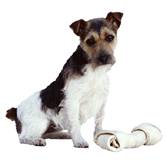
SUNDAY, Jan. 24 (HealthDay News) — Nowadays, even Fido fears the flu.
Boarding kennels and shelters in at least eight states — New York, Pennsylvania, New Jersey, Delaware, Virginia, Colorado, Georgia and Florida — saw outbreaks of canine influenza virus last year. The highly contagious respiratory infection targets dogs of any breed and age in any season, killing up to 2 percent of its victims.
“With any respiratory infection in dogs, you do have the potential for it to morph into a secondary bacterial pneumonia, which then might — if untreated aggressively — result in the death of some animals,” says Edward Dubovi, a professor of virology at Cornell University’s College of Veterinary Medicine in Ithaca, N.Y.
But with proper medical care, dogs usually recover in two weeks without further health complications, says canine influenza virus expert Dr. Cynda Crawford, a veterinarian at the University of Florida College of Veterinary Medicine in Gainesville.
Last July, the first influenza vaccine for dogs received a one-year conditional license from the U.S. Department of Agriculture’s Animal and Plant Health Inspection Service (APHIS) and became available nationwide. The vaccine, made from a killed virus, doesn’t prevent infection, but was shown in clinical trials to reduce the duration of coughing and viral shedding so that dogs are less contagious.
“So far, it performs about as well as the vaccines that we give to people, and horses and pigs,” Crawford said.
Two allergic reactions to the canine influenza vaccine have been reported, but these were more likely related to the individual patient than the product itself, said Lyndsay Cole,
an APHIS spokesperson.
Like human flu, the canine flu virus thrives in crowded conditions, spreading through coughs and sneezes, contaminated objects such as water bowls, and the hands and clothing of people who handle infected animals.
Training facilities, dog shows, dog day-care centers, kennels and grooming salons — anywhere there is a tight grouping of dogs — are typical breeding grounds, and nearly all dogs exposed to the virus get infected, showing flu-like symptoms of coughing, sneezing and runny nose.
Health experts have been tracking dog flu for five years, but the actual incidence nationwide is unknown because no central data collection center exists for infectious diseases in pets.
Canine influenza was identified in 2004 by virologists at Cornell’s Animal Health Diagnostic Center after greyhounds at a Florida racetrack were stricken with an unusual respiratory disease. Researchers determined the dogs had a type of H3N8 influenza ordinarily found only in horses.
Several months later, a pet dog in Florida contracted the virus, setting off a wave of publicity. Since then, canine flu has been documented in 30 states and the District of Columbia.
The virus jumps to new communities mostly from the mass movement of shelter animals throughout the country, Dubovi said. Dogs are routinely taken by rescue workers from high kill shelters, usually in the Southeast, and brought to facilities in other states where they stand a better chance of being adopted.
Because dogs have no natural immunity to the virus, it spreads rapidly in closed environments, such as shelters or boarding kennels, making it difficult to eradicate.
In an effort to combat the problem, the ASPCA in New York City recently launched a three-year study to learn if a reliable rapid screening test can be developed to detect the disease before a new dog enters a shelter’s main population.
Currently, veterinarians take a nasal swab and send the sample to an outside laboratory for analysis, a process that takes days before influenza is confirmed.
People cannot contract the dog flu, and to date it has not emerged in cats that were exposed to infected dogs, Crawford said.
She suggested vaccinating dogs if they fall into one of the following high-risk categories:
- Live in communities where the virus is prevalent.
- Participate in canine conformation or sporting events, such as agility or obedience.
- Go to boarding kennels, training facilities, day-care centers or grooming salons.
People working with dogs should also consider vaccinating their pets. “They don’t want to bring this virus home from their workplace to their own pets and infect them,” advises Crawford. “We’ve had lots of cases like that.”
Those people can help prevent transmission of the virus by washing their hands and clothing in warm soapy water.
Whether this new respiratory virus is here to stay remains to be seen. “It can change and mutate on a whim,” Crawford said.
“Those mutations or genetic changes can either increase the survival of the virus in the population, or the mutations can lead to disappearance of the virus,” she said. “So it can go either way.”
More information
Find out more about canine influenza at the U.S. Centers for Disease Control and Prevention.

